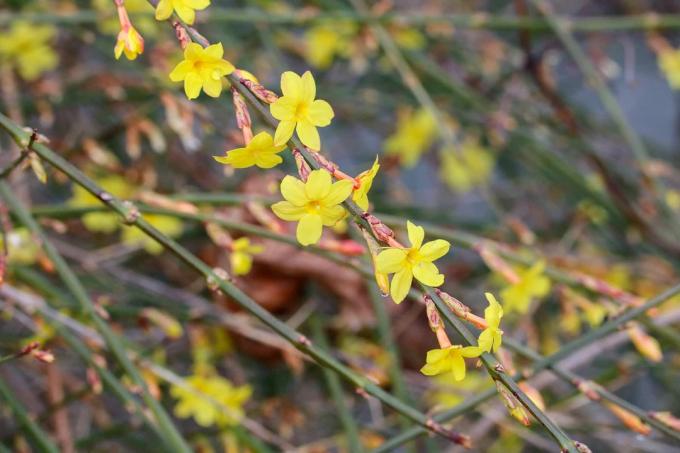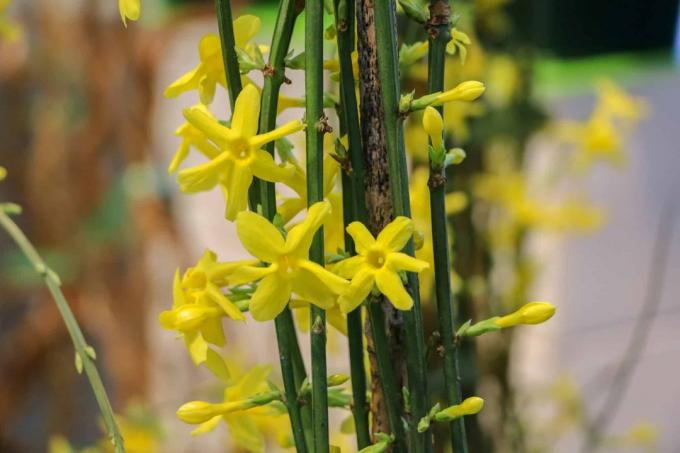
Winter jasmine, with its loose and overhanging growth habit, is ideal for greening house walls, fences or as a small shrub in the front yard. In the right place, it reaches imposing heights. This is what the ideal location for winter jasmine looks like.
In a nutshell
- loves a sunny to light semi-shady location
- plant/place sheltered from the wind
- is heat and drought resistant
- humus and nutrient-rich soil ensures good growth
- Winter protection necessary in the bucket
Table of contents
- Light and warm
- soil claims
- tub culture
- frequently asked Questions
Light and warm
Winter jasmine (Jasminum nudiflorum), native to northern China and East Asia, is, as its name suggests, hardy. The buds easily survive temperatures down to minus 15 degrees. Caution: The flowers that appear on the bare shoots of the previous year can be damaged by severe frosts.
The choice of an appropriate location is particularly important for a rich abundance of flowers on winter jasmine. The robust and easy-care plant loves:
- Sun to light semi-shade
- a sheltered and warm location

The winter broom, as it is also called, also thrives in semi-shade, but here the flowers are sparse. In its original home, jasmine grows on rocky slopes, which makes it insensitive to strong winds. In this country in the garden, however, it should be given a wind-protected place, for example along house walls. This offers him protection against severe frosts. In this way, freezing back can be largely prevented. Heat, strong solar radiation as well as dry and fine dust polluted city air the winter jasmine, on the other hand, tolerates it without any problems.
A notice: those standing alone bright yellow flowers The small shrub, which can be up to five meters high, appears from December until March, depending on the weather. They are about two to three centimeters in size and are not fragrant.
soil claims
Winter jasmine makes no special demands on the soil. As a rule, it gets along well with normal garden soils and also grows on poorer ones sandy soils. However, jasmine should not be planted on soil that is too heavy, such as clay. Here the flowering shrubs are more at risk of frost. Good soil preparation is a prerequisite for optimal growth and a long-lasting, rich bloom. The floor should therefore be designed as follows:
- rich in humus and nutrients
- fresh to moist
- calcareous
- deep, loose and well drained
- slightly sandy to slightly loamy, as well
- slightly acidic to alkaline

A notice: Winter jasmine grows extremely slowly in nutrient-poor and too dry locations. In addition, the flowering is very small or even fails.
tub culture
In addition to its use as ground cover, for greening of walls, walls, fences or in a single position in the garden, the winter jasmine can also be cultivated in a correspondingly large bucket. Here, the spreader climber can reach a height of between 150 and 200 cm with the appropriate climbing aid. If there is no climbing aid, it will only be half as big. Winter jasmine should also have a sunny to semi-shady and sheltered location on the wall of the house in the bucket. Furthermore, please note:
- Pot size 40 liters and more
- Presence of a drainage hole for water
- Pebble drainage layer, expanded clay or pottery shards
- use loose, nutrient-rich, slightly acidic to alkaline soil substrate
As a rule, the soil substrate in the bucket collapses after a while. It is therefore advisable to add a structure-stabilizing material to the soil. For example, lava chippings, pumice or expanded clay are suitable for this.

Tip: The winter jasmine is a superb privacy screen. Due to its growth form, the spreader requires a trellis or climbing aid.
frequently asked Questions
Winter gorse planted in the garden does not need additional protection. The situation is different with bucket specimens. The roots are extremely vulnerable to frost here. It is therefore necessary to place the bucket on a board or styrofoam. In addition, the tub must be wrapped with bubble wrap, fleece, a blanket or jute sack. The root disk is covered with a layer of mulch made of leaves or straw and brushwood.
In order to maintain the willingness of the tree to bloom, it should be pruned regularly. The winter jasmine only flowers on young shoots. If no pruning is carried out, the flower will be detrimental and a lot of deadwood will be formed at the same time. The shrub grows old or bare as a result. A pruning should be done after flowering in April. The shortening of the shoots can be done except for a few eyes. A radical cut or pruning down to dead wood is also tolerated.
Since the jasmine is extremely floriferous, propagation is not particularly difficult. It can be done by cuttings or sinkers. In spring, shoots that are 20 centimeters long can be cut. Then remove all leaves except for two at the tip of the shoot and put the shoot in a pot with potting soil. Keep it frost-free and cool and keep it moist. You can also simply bend long rods (lowers) to the ground and weigh them down with earth.
